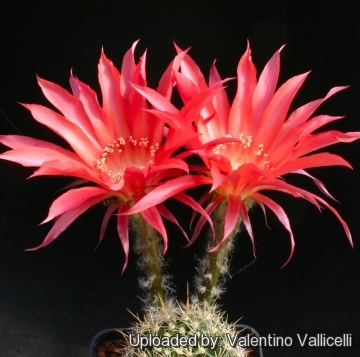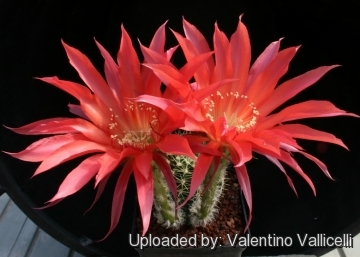




Your support is critical to our success.

Origin and Habitat: Garden origin (Nursery produced cultivar)
Synonyms:
Description: Echinopsis cv. Quirtal SquirtSN|21661]]SN|21661]] is a colourful variety (Peter Mügge hybrid?) with beautiful red flowers at a time, and are quite a sight. Magnificent bloomers, the flowers open nocturnally, or early in the morning, closing by mid morning, and can endure for two-three days (depending on temperature and sun exposure).
Flowers: Medium to large-sized starry.
Tepals: Thin wavy bright red.
Throat: Pale greenish-white.
Throat-circle: White.
Filaments: Magenta.
Anthers: Cream-coloured.
Stigma: Greenish-white.
Subspecies, varieties, forms and cultivars of plants belonging to the Echinopsis hybrid (Echinopsis) group
 Echinopsis cv. Banana Custard: has a kaleidoscopic range of colours ranging from lemon yellow, to apricot and dark magenta.
Echinopsis cv. Banana Custard: has a kaleidoscopic range of colours ranging from lemon yellow, to apricot and dark magenta. Echinopsis cv. Beyond Infinity: has large-sized pinkish-purple flowers with deep red central stripe (Pat Hutchinson hybrid).
Echinopsis cv. Beyond Infinity: has large-sized pinkish-purple flowers with deep red central stripe (Pat Hutchinson hybrid). Echinopsis cv. Coletta: flowers bi-coloured golden yellow and salmon with darker pink mid rib. Tepaloids thin wine-red to tan.
Echinopsis cv. Coletta: flowers bi-coloured golden yellow and salmon with darker pink mid rib. Tepaloids thin wine-red to tan. Echinopsis cv. Copper Beauty: has salmon pink flowers with unusual bronze tones.
Echinopsis cv. Copper Beauty: has salmon pink flowers with unusual bronze tones. Echinopsis cv. Fancy Pants: has ragged candy pink flowers (Pat Hutchinson hybrid).
Echinopsis cv. Fancy Pants: has ragged candy pink flowers (Pat Hutchinson hybrid). Echinopsis cv. Hesperides: has pale salmon-pink flowers.
Echinopsis cv. Hesperides: has pale salmon-pink flowers. Echinopsis cv. Peach Monarch: has peachy-pink flowers. Introduced by Harry Johnson (A Paramount hybrid).
Echinopsis cv. Peach Monarch: has peachy-pink flowers. Introduced by Harry Johnson (A Paramount hybrid). Echinopsis cv. Quirtal Squirt: has beautiful red flowers at a time (Peter Mügge hybrid?)
Echinopsis cv. Quirtal Squirt: has beautiful red flowers at a time (Peter Mügge hybrid?) Echinopsis cv. Raspberry Ripple: has medium- to large-sized blooms, two toned fuchsia pink with dark red central stripe. Very different (Pat Hutchinson hybrid).
Echinopsis cv. Raspberry Ripple: has medium- to large-sized blooms, two toned fuchsia pink with dark red central stripe. Very different (Pat Hutchinson hybrid). Echinopsis hybrid (Echinopsis group): variable hybrids that develop really amazing flowers of different colours and many of these hybrids have cultivar names.
Echinopsis hybrid (Echinopsis group): variable hybrids that develop really amazing flowers of different colours and many of these hybrids have cultivar names.

Echinopsis cv. Quirtal Squirt Photo by: Valentino Vallicelli

Echinopsis cv. Quirtal Squirt Photo by: Valentino Vallicelli
Cultivation and Propagation: These summer-grower plants offer no cultivation difficulties. Cultivate them in rich, airy, porous, growing medium which mainly consists of non organic material such us clay, pumice, lava grit, and only a little peat or leaf-mould. If potted, repot preferably in the spring, if their roots become cramped. Generally, they should be repotted every other year in order to provide fresh soil. However, this doesn't necessarily mean they'll need larger containers. Fill about a quarter of the pot with broken crocks, gravel, etc. to promote good drainage. After repotting, do not water for a week or more. Water regularly in summer (but do not overwater), and let their soil dry out between waterings, keep rather dry in winter. No water should ever be allowed to stand around the roots. Feed with a high potassium fertilizer in summer.
Exposure: Outside they need a bright exposure, full sun or half shade in summer if the location is exceedingly hot or bright, inside needs bright light, and some direct sun. It can tolerate moderate shade, and a plant that has been growing in shade should be slowly hardened off before placing it in full sun as the plant will be severely scorched if moved too suddenly from shade into sun.
Frost Tolerance: Light frost protection required for safe cultivation, but many of the hybrids very frost resistant if kept dry (The hardiness varies from -5°C to -12° C depending on clone). This plants need a period of cool rest in winter to produce flowers abundantly. They flower freely indoors if conditions suit them.
Disese: Watch for infestations of mealybug, scale insects and spider mite.
Propagation: Easy to propagate from cuttings. Most of the Echinopsis clones produce shoots and can be reproduced exclusively by cuttings. The cuttings will take root in a minimum temperature of 20° C. Cuttings of healthy shoots can be taken in the spring and summer, Cut them with a sharp, sterile knife, leave the cutting in a warm, dry place for a week or weeks (depending on how thick the cutting is) until a callus forms over the wound. Once the callus forms, the cutting may be inserted in a container filled with firmed cactus potting mix topped with a surface layer of coarse grit. They should be placed in the coarse grit only; this prevents the cut end from becoming too wet and allows the roots to penetrate the rich compost underneath. The cuttings should root in 2 to 6 weeks.
| Your Actions | |
|---|---|
| Back to Echinopsis index | |
| Back to Cactaceae index | |
 |
Back to Cacti Encyclopedia index |
Privacy stantement - Terms and conditions - How to cite - About us - Feedback - Donate




